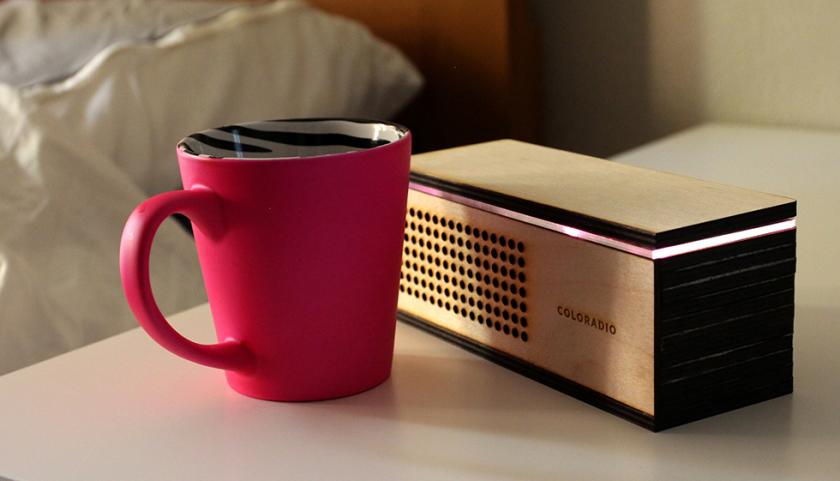
In the ongoing challenge to develop new technological innovations, great minds don’t think alike. It was the diverse intellectual backgrounds and strengths of each teammate that allowed a group of four Illinois graduate students to tackle a design challenge that required a multidisciplinary approach.
GSLIS master’s student Chris Nixon called on his friends Berenice Vargas, a fellow GSLIS master’s student, Kinyetta Nance, a doctoral student at GSLIS, and Helen Zhou, a master’s student studying industrial design, to create a submission for the student design challenge of the 9th International Conference on Tangible, Embedded and Embodied Interaction. The theme of the competition, “Tangible Remote Controls,” tasked competitors with developing a tool that embraces technological advancement while maintaining the strengths and visceral feedback of physical control.
Combining a shared interest in music and their unique skill sets, members of the group created a prototype called Coloradio, a radio that plays music to complement the listener’s environment using color as a trigger. The user simply places any object in front of the geometric array of holes along the box’s wood front. A hidden color sensor signals an Arduino microcontroller, which displays the corresponding color on the radio’s LED light detail and determines audio output using an algorithm that matches music styles with colors.
While engineers might think about the use of knobs or buttons and industrial designers alone might explore efficiencies in other types of control methods, this team approached the problem as one of user convenience, environment, and mood.
 During the brainstorming phase, the group considered the project from a variety of angles, exploring different directions based on the thought processes and priorities of each member. For Nance, a startup enthusiast and entrepreneur, filling a niche in the market was a factor. A student of human-computer interaction, Nixon focused on the most tangible parts of the project. Vargas’s sociology background and empathic nature allowed her to step into the shoes of the potential user and to think about unexpected uses of everyday things. Zhou brought to the group a perspective geared toward implementation and long-term feasibility.
During the brainstorming phase, the group considered the project from a variety of angles, exploring different directions based on the thought processes and priorities of each member. For Nance, a startup enthusiast and entrepreneur, filling a niche in the market was a factor. A student of human-computer interaction, Nixon focused on the most tangible parts of the project. Vargas’s sociology background and empathic nature allowed her to step into the shoes of the potential user and to think about unexpected uses of everyday things. Zhou brought to the group a perspective geared toward implementation and long-term feasibility.
 For Zhou, working with colleagues from LIS opened new avenues of creativity. “I think it’s really fascinating to work with information science people. I think from a design perspective, but they came up with some ideas that really inspired me, that came from a perspective I usually don’t go with.”
For Zhou, working with colleagues from LIS opened new avenues of creativity. “I think it’s really fascinating to work with information science people. I think from a design perspective, but they came up with some ideas that really inspired me, that came from a perspective I usually don’t go with.”
Professor Michael Twidale isn’t surprised that the four worked well together; he’s taught each student in his entrepreneurial IT design course. “What I think is interesting is that the diversity of the intellectual backgrounds of the people in the team allowed them to come up with this astonishingly creative solution to a competition design challenge….That kind of incredibly creative way of solving something I don’t think comes out of one brain. It comes out of several brains, and the brains have to be different,” said Twidale.
